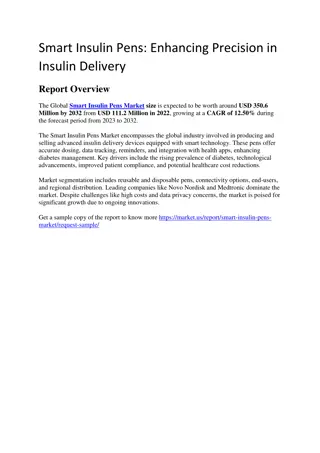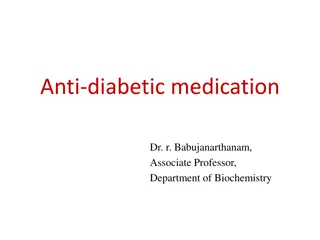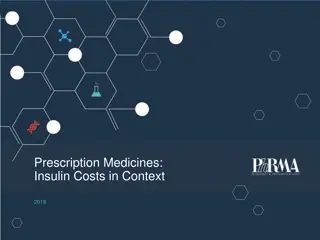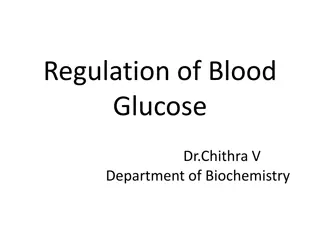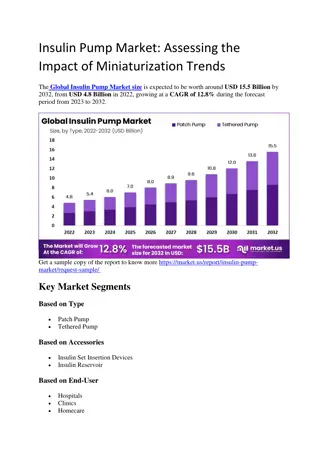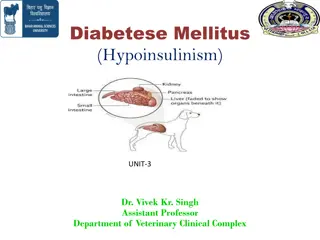Insulin Pump Therapy and Continuous Glucose Monitoring
Exploring the basics of insulin pump therapy, including the basal/bolus concept, operation of insulin pumps, advantages and limitations, day-to-day living with a pump, continuous glucose monitoring, and available systems.
2 views • 45 slides
Efficacy and Safety of Ferric Carboxymaltose for Heart Failure with Iron Deficiency
Iron deficiency is prevalent in heart failure patients with reduced ejection fraction and is linked to poor outcomes. The HEART-FID trial investigates the impact of intravenous ferric carboxymaltose (FCM) on all-cause mortality, heart failure hospitalizations, and exercise capacity in chronic HFrEF
1 views • 17 slides
Mental Deficiency: Causes and Classifications
Mental deficiency, also known as intellectual disability, is characterized by significantly below-average intellectual functioning before the age of 18, along with limitations in adaptive behaviors. It is measured using standardized IQ tests, with classifications ranging from profound to mild. Two m
3 views • 65 slides
Theresa S. Clark - Diabetes Educator Program Coordinator
Theresa S. Clark, MS, RD, LD, CDE, BC-ADM, is a dedicated Diabetes Educator and Program Coordinator at the Diabetes Resource Center in Hopkinsville, KY. She specializes in insulin therapies and teaches patients about insulin administration, carbohydrate counting, and mealtime insulin dosing. Certifi
2 views • 50 slides
The Impact of Smart Insulin Pens on Diabetes Care: Market Perspectives
The Global\u00a0Smart Insulin Pens Market size\u00a0is expected to be worth around\u00a0USD 350.6 Million by 2032\u00a0from\u00a0USD 111.2 Million in 2022, growing at a\u00a0CAGR of 12.50%\u00a0during the forecast period from 2023 to 2032.
0 views • 5 slides
Simulation-Based Training for Diabetes Care in Nursing
This simulation program, SCENS, focuses on enhancing nursing skills in managing diabetes-related complications such as hyper/hypoglycemia. The learning objectives include assessment, safe care provision, insulin administration, and effective communication. The simulation addresses the significant im
0 views • 17 slides
Overview of Anti-Diabetic Medication and Treatment Options
Anti-diabetic medications are used to treat diabetes by lowering glucose levels in the blood. There are various classes of drugs such as insulin, sensitizers, secretagogues, and more, each targeting different aspects of diabetes management. Type 1 diabetes requires insulin injections, while Type 2 d
0 views • 5 slides
United States Insulin Delivery Devices Market
\"The United States Insulin Delivery Devices Market is anticipated to exceed USD 15.97 Billion by 2033, growing at a CAGR of 10.34% from 2023 to 2033.\n\"\n
0 views • 4 slides
Human Insulin Gene Expression and Production
The process of cloning and expressing the human insulin gene has revolutionized the production of insulin for treating diabetes. By using genetically engineered bacteria, the human insulin gene is inserted, expressed, and purified to create insulin for therapeutic use. This innovation has overcome c
2 views • 20 slides
Insights into Insulin Costs and Diabetes Management in 2019
Medical innovation has revolutionized diabetes treatment, providing advanced insulin options for better blood sugar control and reducing complications. Improved medication adherence among diabetes patients can lead to significant cost savings and enhance health outcomes. Despite declining prices for
0 views • 10 slides
Diabetes Mellitus Type 1 Management Guidelines for Athletes
Diabetes Mellitus Type 1 is a chronic endocrine disorder characterized by hyperglycemia, absolute insulin deficiency, and autoimmune origins. This condition, more common among athletes, requires careful monitoring, insulin therapy, blood glucose management during exercise, and recognition of hypogly
0 views • 7 slides
Applications of Recombinant DNA Technology in Biotechnology
Explore the various applications of recombinant DNA technology in biotechnology, including insulin production for diabetes, enzyme production in food biotechnology, and the development of Golden Rice. Understand the process of insulin production using recombinant DNA technology and the significance
0 views • 32 slides
Type 1 Diabetes Pathophysiology and Etiology
Type 1 diabetes is characterized by absolute insulin deficiency, resulting from pancreatic beta cell destruction. It is prone to ketosis with a total deficit of circulating insulin, often due to autoimmune factors. The pathophysiology involves inflammation, immune-mediated cell destruction, and a ch
0 views • 13 slides
Regulation of Blood Glucose and Its Importance in Maintaining Health
Blood glucose regulation is crucial for energy supply in the body, particularly for brain function. Understanding the balance of glucose entering and leaving the blood through processes like absorption, glycogenolysis, and gluconeogenesis is vital. Hormones like insulin and glucagon play key roles i
0 views • 10 slides
Clinical Pharmacy Laboratory DM and Insulin Dosing Regimens
This comprehensive content covers various insulin dosing regimens used in clinical pharmacy laboratories for patients with diabetes mellitus. It includes examples of dosing regimens before meals and at bedtime, methods of insulin administration, vial images, mixing of different types of insulin, and
0 views • 14 slides
Insulin Pump Market
The\u00a0Global Insulin Pump Market size\u00a0is expected to be worth around\u00a0USD 15.5 Billion\u00a0by 2032, from\u00a0USD 4.8 Billion\u00a0in 2022, growing at a\u00a0CAGR of 12.8%\u00a0during the forecast period from 2023 to 2032.
0 views • 4 slides
Insulin Pens Market
The Insulin Pens Market is set to reach $6.73 bn by 2031, growing at 6.7% CAGR. Explore types, diabetes types, distribution channels, and healthcare settings.
0 views • 9 slides
Vitamin K Deficiency in Veterinary Medicine
Vitamin K deficiency in animals can lead to serious health issues due to its crucial role in blood clotting and bone metabolism. Different sources of vitamin K, such as plant material and bacterial fermentation, provide essential forms like K1 and K2. Factors contributing to deficiency include fat m
0 views • 8 slides
Diabetes Mellitus and Dental Plaque
Diabetes mellitus is an endocrine disorder characterized by high blood glucose levels due to insufficient insulin production or ineffectiveness. Type 1 diabetes is insulin-dependent and typically develops in childhood, while Type 2 diabetes is non-insulin dependent and often seen in overweight adult
0 views • 13 slides
Managing Hyperglycemic Crises: DKA and HHS
Hyperglycemic crises such as Diabetic Ketoacidosis (DKA) and Hyperglycemic Hyperosmolar State (HHS) are life-threatening emergencies characterized by severe hyperglycemia and metabolic imbalances. DKA involves absolute or near-absolute insulin deficiency leading to ketone body production and systemi
0 views • 82 slides
Rapid Elemental Analysis of Human Fingernails Using Laser-Induced Breakdown Spectroscopy
Elemental analysis of human fingernails is conducted using Laser-Induced Breakdown Spectroscopy (LIBS) to diagnose and monitor zinc deficiency in the body. Zinc deficiency is a significant health issue globally, affecting billions of people. By utilizing LIBS technology on fingernail samples, resear
0 views • 15 slides
New Recommendations for Insulin Injection Technique and Needle Length - Guided by Expert Advice
The new recommendations emphasize using a 4mm needle for insulin injections to reduce the risk of incorrect administration. This needle length is suitable for children, adolescents, thin adults, and even obese patients. The guidelines also highlight the importance of perpendicular insertion of the n
0 views • 53 slides
Vitamin E Deficiency in Poultry: Symptoms and Implications
Vitamin E deficiency in poultry can lead to serious conditions such as encephalomalacia (crazy chick disease) and exudative diathesis. Symptoms include ataxia, testicular degeneration, and early embryo mortality. Post-mortem lesions show soft and swollen brains with minute hemorrhages. It is crucial
0 views • 14 slides
Pediatric Endocrinology Insulin Dosing Guide
Comprehensive reference for insulin dosing in pediatric endocrinology, covering onset, peak, and duration of action of various insulin preparations, guidelines for twice-daily dosing, managing Dawn Phenomenon and rebound hyperglycemia, and tips for multiple daily injections. Includes information on
0 views • 13 slides
Type 1 Diabetes: Causes, Symptoms, and Treatment
Type 1 diabetes is a condition where the pancreas fails to produce insulin, leading to high blood sugar levels. Without insulin, the body cannot use sugar for energy, resulting in various symptoms like hunger and fat burning. This article provides an overview of diabetes, how insulin works, and the
0 views • 13 slides
Diabetes Mellitus in Dogs: Causes, Symptoms, and Treatment
Diabetes mellitus is a common endocrine disorder in dogs, characterized by symptoms like polyuria, polyphagia, and cataract development. The etiology involves insulin deficiency and insulin resistance, leading to hyperglycemia and various clinical manifestations. Diagnosis is based on symptoms, glyc
0 views • 9 slides
G6PD Deficiency Hemolytic Anemia: Biochemical Basis and Implications
G6PD deficiency hemolytic anemia is an inherited condition characterized by reduced levels of glucose-6-phosphate dehydrogenase (G6PD), leading to impaired production of NADPH. This deficiency affects the Pentose Phosphate Pathway (PPP) and can result in oxidative stress, causing damage to DNA, prot
0 views • 18 slides
Canine Diabetes Mellitus: Causes, Symptoms, and Treatment
Canine diabetes mellitus is a common disease in dogs, primarily affecting middle-aged and older dogs. Unlike Type 2 diabetes in humans, dogs mainly experience insulin-dependent Type 1 diabetes. The condition results from beta cell dysfunction in the pancreas, leading to insulin deficiency. Causes in
0 views • 32 slides
Thiamine Deficiency and Beriberi: Causes, Symptoms, and Treatment
Thiamine (Vitamin B1) deficiency, often seen in conditions like alcoholism and poor dietary intake, can lead to serious health issues such as beriberi. This article delves into the causes, clinical features, and treatment options for thiamine deficiency, including the different types of beriberi and
0 views • 53 slides
Iron Deficiency Anemia and Therapy
Iron deficiency anemia occurs when the body lacks sufficient iron to produce hemoglobin, leading to symptoms like fatigue and weakness. Iron therapy, led by professionals like Dr. Haider Raheem, helps restore iron levels. Important information includes body iron distribution, absorption mechanisms,
0 views • 27 slides
Anemia in Pregnancy: Types, Etiology, and Management
Dr. Methal A. Alrubaie, an assistant professor, presents a detailed overview of anemia in pregnancy. The content covers the classification of anemia types, their etiology, clinical presentation, effects on both mother and fetus, investigation methods, and treatment approaches. Various types of anemi
0 views • 19 slides
Revolutionizing Diabetes Care with Innovative Insulin Pump Solutions
Diabetes is a serious health condition affecting millions worldwide. This project aims to address the growing prevalence of diabetes by introducing advanced insulin pump technology. With a focus on the US market and a comprehensive strategy, including market information, components of insulin pumps,
0 views • 14 slides
Inborn Errors of Amino Acid Metabolism
Inborn errors of amino acid metabolism are caused by enzyme loss or deficiency due to gene mutations, leading to various disorders like Phenylketonuria (PKU), Maple Syrup Urine Disease, Albinism, Homocystinuria, and Alkaptonuria. PKU is the most common disease, characterized by phenylalanine accumul
0 views • 25 slides
Diabetic Ketoacidosis
Diabetic Ketoacidosis (DKA) is a serious complication of diabetes characterized by high blood sugar, acidic ketones, and dehydration. This condition is triggered by factors like insulin deficiency, illness, infections, and stress. The role of insulin is crucial in managing glucose levels and prevent
0 views • 25 slides
Blood Dyscrasia
These disorders, including anemia and hemolytic anemia, affect red and white blood cells, leading to a variety of symptoms and causes such as iron deficiency, blood loss, and immune destruction. Anemia subtypes like iron deficiency, folate deficiency, and pernicious anemia are elucidated, along with
0 views • 30 slides
Deficiency Diseases and Their Impact on Health
Vitamins and minerals play a crucial role in maintaining overall health, and a deficiency in these essential nutrients can lead to various deficiency diseases. Some common examples include night blindness due to lack of Vitamin A, scurvy caused by Vitamin C deficiency, beriberi resulting from a lack
0 views • 8 slides
Vitamin A Deficiency: Causes, Symptoms, and Management
Retinol, the alcohol form of vitamin A, is essential for vision, bone growth, and epithelial tissue maintenance. Hypovitaminosis-A can result from inadequate intake or absorption issues, leading to night blindness, keratinization, weight loss, and infertility. Factors contributing to deficiency incl
0 views • 11 slides
Investigation and Management of Vitamin B12 Deficiency
Uncertainties exist in defining B12 deficiency with no gold standard test. Clinical presentation is crucial. New NHS Lothian guidelines aim for a pragmatic approach, comprehensive testing, and increased oral B12 use to ease burden on patients. Guidelines on diagnosing B12 levels, addressing macrocyt
0 views • 10 slides
Iron Deficiency: Prevalence, Symptoms, and Implications
Iron deficiency is a significant concern in India, particularly affecting children, pregnant women, and older adults. The prevalence varies across demographics, with notable impacts on health and well-being. Recognizing the signs and symptoms of iron deficiency is crucial for early intervention and
0 views • 13 slides
Anemia: Definition, Classification, and Treatment
Anemia is a condition characterized by a deficiency in red blood cells or hemoglobin, resulting in symptoms like fatigue, breathlessness, and palpitations. This collection of images and information covers various aspects of anemia, including its classifications such as hemorrhagic, hemolytic, and ap
0 views • 12 slides




